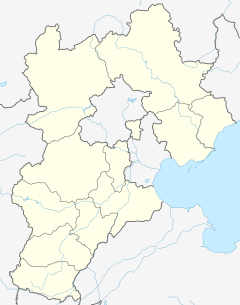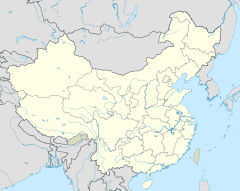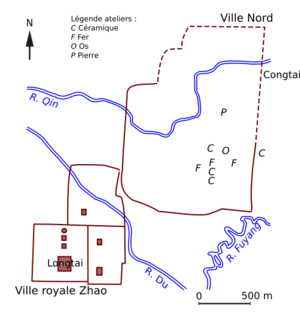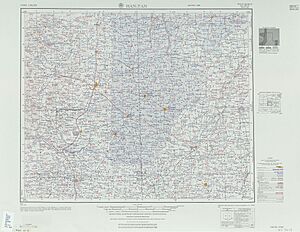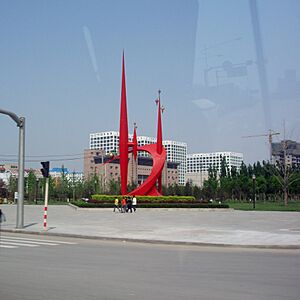Handan facts for kids
Quick facts for kids
Handan
邯郸市
Hantan
|
|
|---|---|
|
Prefecture-level city
|
|
|
Clockwise from the top: Skyline of Handan, Guangfu Ancient City, Qibugou Scenic Area, wide view of downtown, Congtai Park, statue of foreign-clothed cavalry
|
|
| Nickname(s):
Dream City (梦城)
|
|
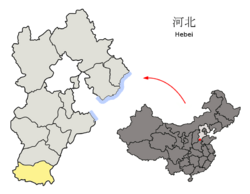
Location of Handan City jurisdiction in Hebei
|
|
| Country | People's Republic of China |
| Province | Hebei |
| Settled | 6500 BC |
| Established | November 15, 1983 |
| Area | |
| • Prefecture-level city | 12,068 km2 (4,659 sq mi) |
| • Urban | 556.00 km2 (214.67 sq mi) |
| • Districts | 2,649.1 km2 (1,022.8 sq mi) |
| Population
(2020)
|
|
| • Prefecture-level city | 9,433,000 |
| • Density | 781.65/km2 (2,024.47/sq mi) |
| • Urban | 2,845,790 |
| • Districts | 4,012,000 |
| GDP | |
| • Prefecture-level city | CN¥ 315 billion US$ 50.5 billion |
| • Per capita | CN¥ 33,450 US$5,371 |
| Time zone | UTC+8 (China Standard) |
| ISO 3166 code | CN-HE-04 |
| Vehicle registration | 冀D |
| Handan | |||||||||||||||||||||||||||
|---|---|---|---|---|---|---|---|---|---|---|---|---|---|---|---|---|---|---|---|---|---|---|---|---|---|---|---|

"Handan" in Simplified (top) and Traditional (bottom) Chinese characters
|
|||||||||||||||||||||||||||
| Traditional Chinese | 邯鄲 | ||||||||||||||||||||||||||
| Simplified Chinese | 邯郸 | ||||||||||||||||||||||||||
| Postal | Hantan | ||||||||||||||||||||||||||
| Literal meaning | "the city at the terminus of Mount Han" | ||||||||||||||||||||||||||
|
|||||||||||||||||||||||||||
Handan is a large city in the southwest of Hebei province, China. It is the southernmost city in Hebei and shares borders with other provinces like Shanxi, Henan, and Shandong. In 2010, over 9 million people lived in Handan, with nearly 3 million in its main urban areas.
Handan is one of China's oldest cities, first settled around 6500 BC by the Cishan culture. It has played a big role in Chinese history and culture. It was once the capital of the ancient State of Zhao. Handan is also known as the birthplace of Tai chi and where the first compass was made from special magnetic stones. Because of its rich past, Handan is recognized as one of China's National Famous Historical and Cultural Cities.
Contents
What's in a Name? The Meaning of Handan
The name Handan (Chinese: 邯郸) has stayed the same for more than 2,000 years. It first appeared in an ancient record called Bamboo Annals during the time of King Zhou of Shang.
A dictionary from the Tang dynasty explained the name. It said "Han" (Chinese: 邯) comes from a nearby mountain called Hanshan. "Dan" (Chinese: 单) meant "the end of a mountain," with an extra part (Chinese: 阝) showing it's a city. So, "Handan" meant "the city at the end of Mount Han."
However, in 1965, jade writings were found that spelled "Dan" as "丹", which means red. This led to a new idea: maybe Handan was named because Mount Han looked reddish-purple. Over time, the different spellings became the modern one we use today.
Handan's Long and Amazing History
Handan was an important city for the ancient State of Zhao during the Warring States period (about 5th to 3rd centuries BCE). It was their second capital city. King Wuling of Zhao made Zhao a strong opponent of the Qin state. He was one of the first to build walls to protect new lands, which later inspired the famous Great Wall of China.
The first emperor of China, Qin Shi Huang, was born in Handan. The State of Qin eventually conquered Zhao and Handan.
Handan was still an important center for culture and trade during the early Han dynasty. It slowly became less important after many battles in northern China. However, it kept its fame for making beautiful Cizhou ware pottery. Handan is also the birthplace of Yang-style tai chi, a famous martial art.
Even though much of its ancient past is gone, Handan still has places linked to famous Chinese stories. For example, Congtai Park is where the ancient Zhao court used to be. Nearby is the "Xuebu Bridge" (学步桥), or "Learning to Walk Bridge."
The Story of Learning to Walk
Legend says a noble from the state of Yan heard about a special way of walking in Handan. He came to Handan and spent weeks trying to learn it. But he failed and forgot how to walk normally! He had to crawl back home. This story led to the Chinese saying, "to learn the walk of Handan" (邯郸学步, Hándān xué bù). It means trying too hard to learn something difficult and forgetting the basics.
The Xiangtangshan Caves near Handan have huge Buddha statues carved into the mountains. Some of these statues are from the 6th century.
How Handan is Governed
Handan is a large city with many people. In 2010, the total population was over 9 million. The city is divided into different areas called districts and counties. The main government offices are in Congtai District.
The city's leaders work to manage the population and services. This includes things like public safety and local government.
Handan's Climate
Handan has a climate that changes a lot with the seasons, like many places in the North China Plain. Summers are hot and wet, while winters are cold and dry. Most of the rain falls in July and August. The average temperature for the year is about 14.3 degrees Celsius (57.7 degrees Fahrenheit).
| Climate data for Handan (1991–2020 normals, extremes 1981–2010) | |||||||||||||
|---|---|---|---|---|---|---|---|---|---|---|---|---|---|
| Month | Jan | Feb | Mar | Apr | May | Jun | Jul | Aug | Sep | Oct | Nov | Dec | Year |
| Record high °C (°F) | 19.7 (67.5) |
25.3 (77.5) |
31.7 (89.1) |
37.9 (100.2) |
40.0 (104.0) |
43.6 (110.5) |
42.0 (107.6) |
37.2 (99.0) |
40.1 (104.2) |
33.5 (92.3) |
28.6 (83.5) |
28.4 (83.1) |
43.6 (110.5) |
| Mean daily maximum °C (°F) | 4.2 (39.6) |
8.7 (47.7) |
15.3 (59.5) |
22.1 (71.8) |
27.7 (81.9) |
32.5 (90.5) |
32.5 (90.5) |
30.8 (87.4) |
27.3 (81.1) |
21.4 (70.5) |
12.8 (55.0) |
6.0 (42.8) |
20.1 (68.2) |
| Daily mean °C (°F) | −0.7 (30.7) |
3.1 (37.6) |
9.5 (49.1) |
16.1 (61.0) |
22.0 (71.6) |
26.6 (79.9) |
27.8 (82.0) |
26.2 (79.2) |
21.8 (71.2) |
15.5 (59.9) |
7.3 (45.1) |
1.1 (34.0) |
14.7 (58.4) |
| Mean daily minimum °C (°F) | −4.5 (23.9) |
−1.3 (29.7) |
4.3 (39.7) |
10.5 (50.9) |
16.2 (61.2) |
21.1 (70.0) |
23.6 (74.5) |
22.4 (72.3) |
17.3 (63.1) |
10.7 (51.3) |
3.0 (37.4) |
−2.8 (27.0) |
10.0 (50.1) |
| Record low °C (°F) | −15.0 (5.0) |
−14.4 (6.1) |
−6.1 (21.0) |
0.0 (32.0) |
7.7 (45.9) |
11.5 (52.7) |
16.5 (61.7) |
13.7 (56.7) |
5.4 (41.7) |
−1.0 (30.2) |
−11.4 (11.5) |
−12.7 (9.1) |
−15.0 (5.0) |
| Average precipitation mm (inches) | 3.2 (0.13) |
7.6 (0.30) |
9.8 (0.39) |
27.1 (1.07) |
40.8 (1.61) |
50.7 (2.00) |
147.0 (5.79) |
122.7 (4.83) |
46.5 (1.83) |
26.3 (1.04) |
14.9 (0.59) |
3.5 (0.14) |
500.1 (19.72) |
| Average precipitation days (≥ 0.1 mm) | 2.4 | 3.1 | 2.8 | 5.2 | 6.5 | 8.2 | 10.8 | 9.6 | 7.0 | 5.4 | 3.8 | 2.3 | 67.1 |
| Average snowy days | 3.7 | 3.0 | 1.1 | 0.2 | 0 | 0 | 0 | 0 | 0 | 0 | 1.3 | 2.7 | 12 |
| Average relative humidity (%) | 57 | 53 | 50 | 54 | 56 | 56 | 72 | 76 | 69 | 64 | 64 | 60 | 61 |
| Mean monthly sunshine hours | 133.1 | 149.2 | 198.5 | 222.3 | 252.7 | 228.4 | 192.1 | 193.7 | 179.5 | 177.0 | 144.3 | 138.0 | 2,208.8 |
| Percent possible sunshine | 43 | 48 | 53 | 56 | 58 | 52 | 43 | 47 | 49 | 51 | 48 | 46 | 50 |
| Source: China Meteorological Administration | |||||||||||||
Handan's Economy and Tourism
Handan's economy has grown a lot in the last 20 years. It's a big producer of coal and steel. Coal mines in Fengfeng provide energy for Handan's factories that make iron, steel, and textiles. Other industries like chemical and cement plants also operate here.
Farmers in Handan grow corn, pomegranates, and raise chickens for eggs. The city also has a growing service industry, including shops, banks, and trading businesses.
Air Quality Improvements
In the past, Handan faced challenges with air pollution because of its many factories. However, the government has worked hard to make the city cleaner. They closed down some polluting power plants. Now, Handan has many more days with good air quality compared to a few years ago.
Fun Places to Visit
Handan Prefecture has some amazing places for tourists. These include the ancient Guangfu Ancient City and the Nüwa Imperial Palace. These are considered top tourist spots in China.
Getting Around Handan
Handan has its own airport, Handan Airport. For train travel, there are two main stations: Handan railway station for regular speed trains and Handandong railway station for high-speed trains. This makes it easy to travel to and from the city.
People and Beliefs in Handan
Handan is home to many different groups of people. In 2007, there were 40 different ethnic groups living in Handan. About 50,000 people belong to ethnic minority groups, with most of them being Hui people. There are special schools for Hui children in Handan.
Religions in Handan
The most common beliefs in Handan are traditional Chinese folk religions, which include Taoism and Buddhism.
There are also many Christians in Handan. In 2013, there were over 150,000 Catholics. The Mother of Grace Cathedral in Daming County was built in 1918. There are also about 300,000 Protestants. The largest Protestant church was built in 1997. Handan also has about 30,000 Hui Muslims.
Handan's Rich Culture and Famous Sayings
Handan is known as the "capital of Chinese idioms." During the Warring States period, it was a busy and important city that attracted many smart people. More than 1,500 idioms and proverbs are linked to Handan.
Famous Chinese Idioms from Handan
Here are some well-known idioms that come from Handan:
- 邯鄲學步 (literally: "to study the walking method of Handan"): This means to copy others so much that you lose your own unique way.
- 黃粱一夢 (literally: "millet dream"): This refers to a pipe dream or an impossible fantasy.
- 頂天立地 (literally: "stand upright on one's two legs between heaven and earth"): This describes someone who is very independent and strong.
- 圍魏救趙 (literally: "to besiege the State of Wei to rescue the State of Zhao"): This means to help a friend in trouble by attacking their enemy somewhere else.
- 不可同日而語 (literally: "mustn't speak of the two things on the same day"): This means two things are so different they cannot be compared.
- 驚弓之鳥 (literally: "a bird frightened by the mere sound of shooting arrows"): This describes a person who is very scared and easily panicked.
- 完璧歸趙 (literally: "returning the Jade to Zhao"): This means to return something to its owner in perfect condition.
- 負荊請罪 (literally: "carrying thorned grass and pleading guilt"): This means to offer a very humble apology to someone.
Notable People from Handan
Many important people in Chinese history and modern times were born in Handan:
- Lian Po: A great military general from the Zhao state.
- Lin Xiangru: A clever politician from the Warring States period, known for his wisdom.
- Xun Kuang: A famous philosopher who followed the ideas of Confucianism.
- Qin Shi Huang: The first emperor of China, who united the country.
- Cao Cao: A powerful leader, poet, and warlord during the Three Kingdoms period.
- Yang Luchan: A very important teacher of Tai chi.
- Zhang Weili: A famous mixed martial artist, known as "Magnum," who was the first Chinese UFC champion.
Sister Cities
Handan has friendly connections with cities around the world, called "sister cities." These connections help build cultural understanding and cooperation.
 Kryvyi Rih, Dnipropetrovsk, Ukraine
Kryvyi Rih, Dnipropetrovsk, Ukraine








